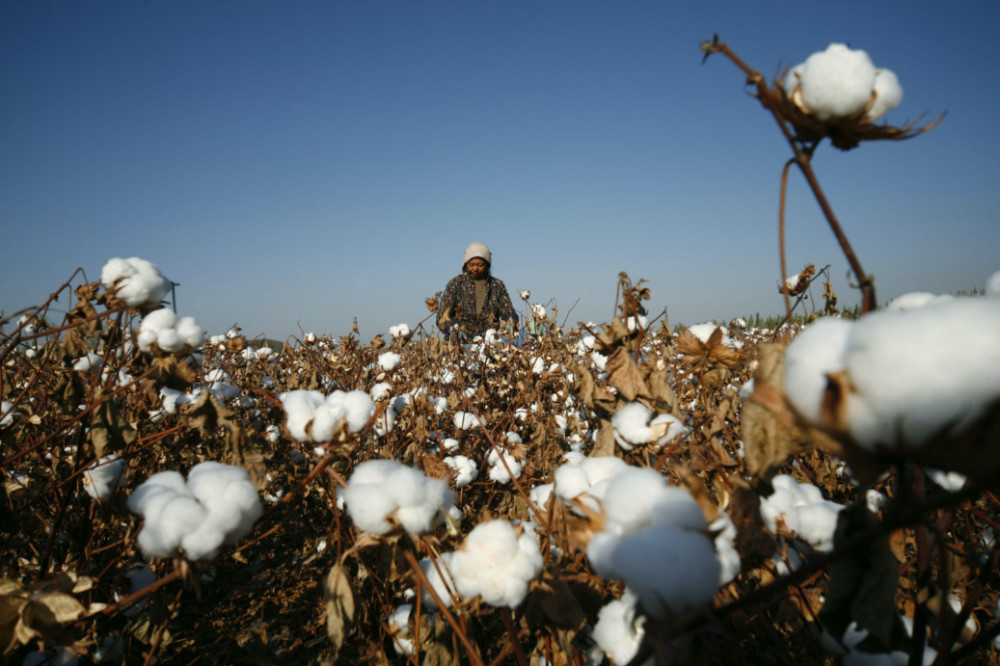A crackdown by the United States on cotton imports from China’s Xinjiang region is a “big red flag” that should spur retailers to ensure their supply chains are free of forced labor involving Uighur Muslims, according to a senior US customs official.
US Customs and Border Protection said last week it would detain all imports of cotton and tomato products from Xinjiang and require companies to either prove the products were slavery-free or ship them elsewhere.

A farmer picks cotton on a farm on the outskirts of Hami, Xinjiang Uighur Autonomous Region on 3rd November, 2010. US and China cotton futures climbed to all-time highs on Wednesday as tightening global supplies and strong demand from the world’s top importer, China, continued to bolster the markets. PICTURE: Reuters/Stringer
The United Nations estimates at least one million Uighurs and other Muslims have been detained in Xinjiang, and many are said to be put to work. China denies mistreatment and says the camps are vocational training centres needed to combat extremism.
CBP official Brenda Smith said seizing imports would “send a message” over forced labor concerns in Xinjiang but that businesses had an even bigger role to play in preventing tainted cotton from entering the United States.
“[The order] is a big red flag…a strong recommendation that the business community remove the risk from their supply chains,” Smith, executive assistant commissioner of CBP’s trade office, told the Thomson Reuters Foundation in an interview.
“What is most important is that businesses hear the message and take action.”
Smith said she expected US retailers to do due diligence down to the third or fourth tiers of their supply chains. Yet labour rights campaigners say most brands have limited to no knowledge around sourcing beyond their main “Tier 1” suppliers.
The US Government agency estimates that about $US9 billion of cotton goods and $US10 million worth of tomato products were imported from China into the United States in the past year.
Under a 2016 law, it is illegal to import goods into the United States that are made entirely or in part by forced labour – which includes prison work, bonded labour and child labor.
Challenges ahead
The western province of Xinjiang – home to about 11 million ethnic Uighurs – produces about 85 per cent of China’s cotton and 20 per cent of the global supply, which is used by fashion brands worldwide.
The region-wide crackdown follows a move last month to block cotton imports from China’s largest producer, the military-linked Xinjiang Production and Construction Corps.
About 43 shipments of cotton-based goods have been detained at US entry ports since the XPCC order, according to CBP.
Labour rights and supply chain experts have welcomed the Xinjiang-wide order but said enforcing it would be difficult.
Apparel and retail groups said in a joint statement this week that members were working to remove forced labour from their supply chains but hoped to work with CBP “to make sure that enforcement is smart, transparent, targeted and effective”.
While most brands say they do not source directly from factories in Xinjiang, their supply chains are likely tainted by cotton picked by Uighurs that is exported across China and used by other suppliers, according to campaigners and researchers.
“The complexity and opacity of the brands’ supply chains create major challenges and CBP’s track record on enforcement is mixed, but it can be done,” Scott Nova, head of the US-based Workers Rights Consortium, said in a statement this week.
CBP’s drive to prevent imports made by forced labor has been hampered by a lack of skilled staff and reliable data, the US Government Accountability Office said in October.
The agency’s efforts to address forced labour have “evolved significantly” over the last five years, Smith said. CBP was unable to provide data on staff numbers and budgets by deadline.
Smith acknowledged that implementing the new order would be challenging but said CBP was testing new technology to assess finished goods and garments and pinpoint the source of cotton.
“For now, the best way to identify origin of cotton is to go back and ask questions,” she said. “That’s certainly what we’ll be doing and hope the business community will do as well.”





